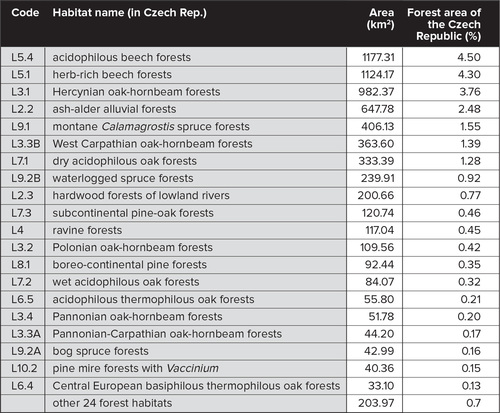Nature Conservation 2023 — 5. 6. 2023 — Nature and Landscape Management — Print article in pdf
What Does the European Union´s Nature Restoration Law Mean for Forests in the Czech Republic?
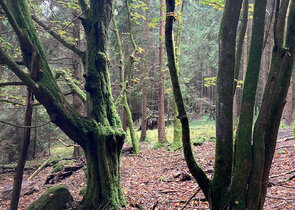
The Nature Restoration Law sets a challenging (and if fulfilled, probably effective) goal of implementing measures to improve the state of natural habitats by 2050 wherever it is needed, and by 2030 on at least 20% of EU land and sea areas. Formal implementation of established (technological) procedures for the restoration of forest habitats, only applied within the prescribed territorial scope, is not sufficient for truly improving the condition of forest habitats and the populations of wildlife bound to them. If we are to achieve real restoration of nature, how the Nature Restoration Law is implemented, will be very important. Not only in the case of forests (but especially with them), we should significantly employ the creative forces of nature itself and, simultaneously, sensibly use an active management approach.
Nature restoration of forest ecosystems in general
Forests cover almost 44% of the European Union and thus form a significant part of the environment which is less affected by human activity. In the Czech Republic, forest makes up 34% of the coountry´s territory, and almost a quarter of the forest area (8% of the Czech Republic as a whole) is occupied by natural forest habitats defined according to the Habitats Catalogue (see Tab. 1). A large part of natural forest habitats, including those with the largest size, are in a condition that does not allow the establishment of viable populations in a significant part of the species bound to the given habitats (RYBICKI et al. 2020). This is evidenced by long lists of extinct and endangered species in the so-called Black and Red Lists or Books of various taxa/groups (e.g. HOLEC & BERAN 2006, LIŠKA et al. 2008, HEJDA et al. 2017). The Nature Restoration Law aims at changing this situation.
Table 1: Extent of the most important forest habitats in the Czech Republic and their proportion of forest area (in %); specifically, all habitats with a share higher than 1% are listed, excluding the area of natural forest habitats in mosaics (data source: Updated habitat mapping layer, Nature Conservation Agency of the Czech Republic 2022).
The basis for the restoration of nature in individual EU Member States is to be the so-called national restoration plans for nature, which, based on the results of research and preparatory monitoring, will determine the areas that need to be restored in order to determine the halting of the decline in biodiversity and other Nature Restoration Law objectives. The selection of specific areas is to take into account "the sufficient quality and quantity of the habitats of the species required for achieving their favourable conservation status, taking into account the areas most suitable for re-establishment of those habitats, and the connectivity needed between habitats in order for the species populations to thrive, as well as ongoing and projected changes to environmental conditions due to climate change" (Article 11, paragraph 2b of the Nature Restoration Law). In the text of the Nature Restoration Regulation, emphasis is consistently placed on national restoration plans being the result of a process open to the general public and assessment based on the latest scientific knowledge.
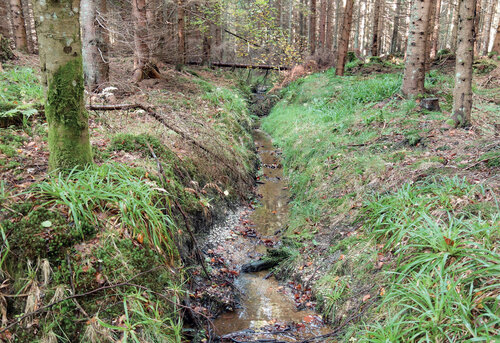
Drainage canal in the Pivonické skály/Oivonice Rocks Nature Reserve immediately adjacent to the Žofínský prales/Žofín Primeval/Virgin Forest National Nature Reserve. © Jeňýk Hofmeister
The Nature Restoration Regulation closely follows the EU Biodiversity Strategy for 2030, as it envisages a significant contribution from protected areas to nature restoration. The EU Biodiversity Strategy obliges Member States to extend protected areas to 30% of their total area, and to strictly protect 10% of the area. Strict protection means support of natural restoration of natural habitats and effect of natural processes by maximally limiting the influence of human activity. Strict protection is an effective tool, especially for such habitats and areas whose restoration will occur spontaneously through their unprompted development after stopping or limiting the human activity impacts. For a number of widespread forest habitats (e.g. acidophilous and herb-rich beech forests, montane Calamagrostis and waterlogged spruce forests), strict protection can be a sufficient (even ideal) measure leading to the restoration of their natural value and the recovery of biodiversity within a short time (paragraph 10 of the justification of the Nature Restoration Law). It has already been clear from the above that one of the basic pillars of nature restoration in forest habitats should be a breakthrough change in the intensity, methods, and scope of forest management, which in the Czech Republic still have been dominantly represented by age-class forestry in even-aged stands. It is obvious that such a change will not be easily enforced in circumstances where an (un)certain part of traditionally minded foresters do not imagine forest habitat restoration as anything other than "restoration of the stand" (in the sense of the forestry definition) after clearing the previous stand.
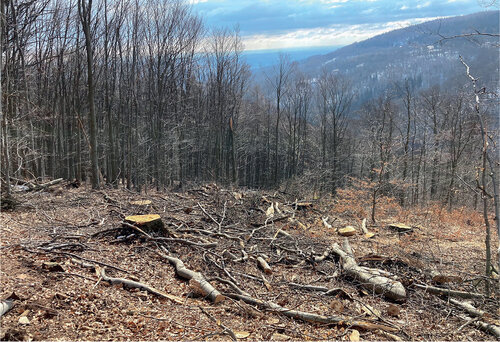
A fragment of a 240-year-old beech forest in the Východní Krušnohoří/Eastern Ore Mts. Special Area of Conservation pursuant to the EU Habitats Directive, logged by the Lesy ČR/Forest of the Czech Republic, State Enterprise in spring 2022. © Jeňýk Hofmeister
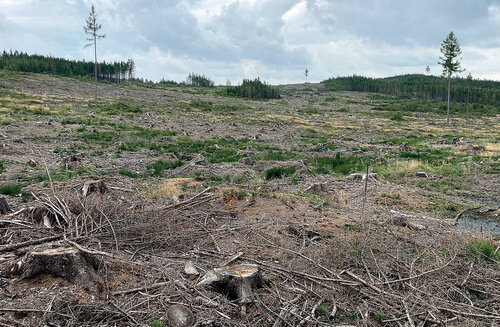
Extensive clearings as a consequence of the European spruce bark beetle (Ips typographus) outbreak/plague, almost entirely lacking biological heritage of the previous forest generation, have emerged in recent years in the Brdy Highlands Protected Landscape Area (northern slope of Březový vrch/Birch Hill, September 2022).© Jeňýk Hofmeister
A fundamental change in forest management does not mean that we should completely give up on the economic use of forest stands. Only a small part of forest habitats, roughly corresponding to 10% of the forest area in the Czech Republic, should remain strictly protected. This strict protection includes both the exclusion of forest management as the main tool and active management to support biodiversity at selected sites (VAN MEERBEEK et al. 2019). In most other economic forest stands, the fundamental change in forestry approach should consist precisely of the protection of so-called biological heritage (structures of old forests) and the variability of natural conditions. Within nature restoration of forest habitats, biological heritage protection should become a natural part of management in a significant part of ordinary commercial forests, and not just a prerogative of commercial forests in protected areas (see Box).
The importance of protected areas
Let us go back to the importance of protected areas for nature restoration of forest habitats. The fulfilment of the Nature Restoration Law objectives cannot be imagined without a truly significant increase in the area of strictly protected forest habitats. Strict protection means the exclusion of forest management and other direct human intervention on a significant part of strictly protected habitats. However, in order to support biodiversity in habitats significantly affected by specific management methods in the past (forest pasture or middle forest in various types of lowland forests), strict protection allows the implementation of measures replacing the beneficial influence of historical management. At the same time, these active steps to support biodiversity may include, for example, active support for the creation of habitat trees and dead wood, or "breaking" the homogeneous structure of dense young forest stands created by intensive artificial regeneration after large-scale random logging. All these mea-sures are aimed at improving habitat condition and they are not in any way ordinary management interventions as applied in commercial forests. These active measures are therefore very different from current forestry practice. In the Czech Republic, there are very few sites where these measures have been applied in a qualified manner, even though the knowhow has existed for a long time (GÖTMARK 2013, THORN et al, 2020). In some cases, these measures are financially unprofitable, so that, at least initially, their practical application depends on requirements and financial subsidies from the State Nature Conservancy.
Another important measure is the restoration of the forest water regime. This is a fundamental measure that should include wetlands, peatbogs, water features, and streams of all levels, and should be applied at a landscape scale (LÕHMUS et al. 2015). These measures will probably lead to (at least temporary) waterlogging of larger forest areas, which may lead to restrictions in their economic use. On the other hand, they can very effectively help to improve the hydrological balance of restored habitats and their surroundings, if there is a sufficient area of forests with a restored water regime at the landscape level.
Forestry management cannot avoid significant changes even in forests outside protected areas. The Nature Restoration Law requires that all ecosystems in the landscape, including forest ones, are used in such a way that they are in a condition that enables effective capture and accumulation of carbon (point 18 of the Nature Restoration Law justification). It is based on the fact, that, on the one hand, forest ecosystems (and the organisms living in them) are sensitive to climate change, but, on the other hand, they can be an effective tool for mitigating the adverse effects of climate change (point 56 of the justification).
According to current estimates, temperate zone forests contribute a (significant) quarter of the global sequestration of CO2 by forest ecosystems (PAN 2011). Accumulation capacity generally increases with the age of a tree; a single healthy large old tree can capture and accumulate a comparable amount of CO2 as a young stand in the same period (e.g. one year) or a tree several decades old in its entire lifetime (STEPHENSON et al. 2014). Even in naturally developing forests, large old trees usually make up only a fraction of the total number of trees, but their share in the total production of the ecosystem (thus also sequestering carbon) remains significant (LUTZ et al. 2018). Excluding selected trees and entire stands from logging and leaving them to naturally age, die, and decay can be a very effective measure to support the carbon storage capacity of the forest habitats. Even extending the rotation period has a positive, albeit relatively short-lived, effect on the amount of carbon accumulated in the wood.
Restoration of forest ecosystems – Article 10
Article 10 of the Nature Restoration Regulation, which is relatively brief, is specifically devoted to the restoration of forest ecosystems. The article contains only two points. The first states that the restoration of forest ecosystems has to be aimed at supporting the biodiversity of forest organisms. The second point specifies that Member States shall achieve an increasing trend at national level of each of the following indicators in forest ecosystems measured in the period from the date of entry into force of the Regulation until the end of 2030, and every three years thereafter, until the satisfactory levels identified are reached: (a) volume of standing dead wood; (b) volume of lying deadwood; (c) share of forests with uneven age structure; (d) forest connectivity; (e) common forest bird index (based on a list created specifically for each EU country;, and (f) stock of organic carbon (in litter and mineral soil at a depth of 0 to 30 cm).
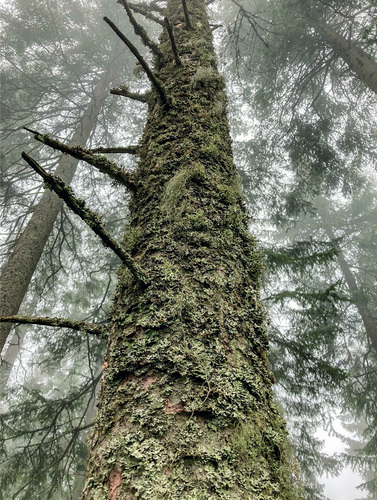
A standing dead Norway spruce becomes a valuable habitat for many lichen species not finding suitable conditions on living spruce trunks (top part of the Boubínský prales/Boubín/Kubany Primeval/Virgin ForestNational Nature Reserve). © Jeňýk Hofmeister
The selection of indicators can be considered a good compromise based on the latest scientific literature, which, on the one hand, ensures sufficient information about the quality of forest habitats from the point of view of various groups of forest organisms and carbon accumulation. On the other hand, it does not prevent the acquisition of this information due to excessive input, and technical and financial complexity of carrying out repeated surveys. Based on current knowledge, it can be assumed, that the increasing trend of selected indicators (or the crossing of certain quantitative limits) can reliably serve to assess the increase in forest habitat potential for the forest species richness. In order to achieve an increasing trend in indicators, it is necessary to use natural processes as much as possible and human interventions only to a properly justified extent. To a certain extent, this can also be applied to management measures carried out in order to support photophilous species in various types of oak forests, which are currently considered by some experts to be indispensable for the survival of species or entire communities from the relevant taxonomic groups (most often insects).
If we manage to create a functional network of forest habitats at the landscape (or even better, regional) level, open to the action of natural disturbances and more complete food chains (including large herbivores and their predators), we may be surprised at how much in protecting specific open forest habitats from overgrowth is done by nature itself. Nature conservation efforts could then be more concentrated on small sites isolated in the cultural landscape, which would remain outside the reach of the beneficial effects of restored forest ecosystems.


